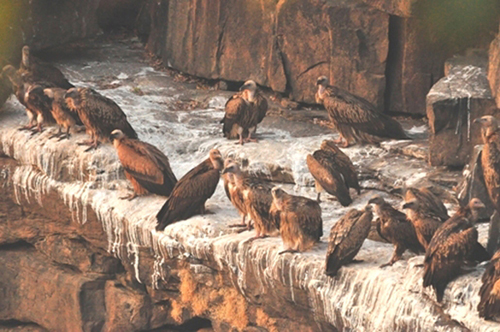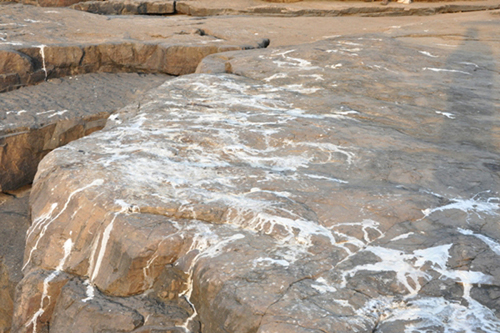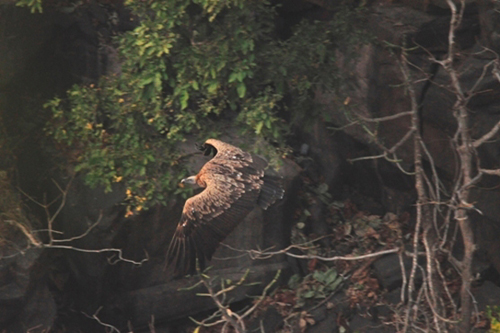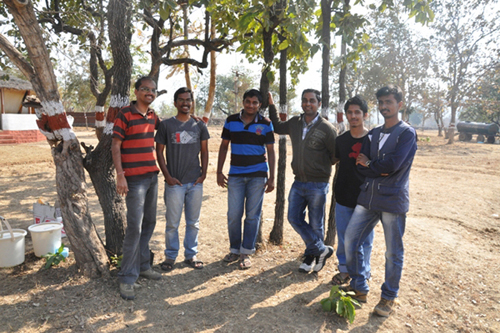Vulture Estimation at Panna Tiger Reserve.
A brief field trip Report.
-Ajay Gadikar
Since the last 4 years Panna Tiger Reserve (PTR) has been organizing a Vulture population estimation program during the month of January-February. I had attended their last three camps and want to share with you the experiences of one such Vulture Estimation
exercise in which I stayed inside the dense Panna Tiger Reserve.
As you all know Vulture is one of the species that’s facing real risk of getting extinct. The IUCN (International Union for Conservation of Nature) in its red list of threatened species puts this species as critically endangered, as almost 97% to 99%
of the vulture population has been wiped out from the wild in the last 15-20 years. This is very alarming, so immediate steps were taken to save the species. One such step was the survey to find out how many vultures are remaining in PTR which is a good
habitat of vultures.
Our country/region is represented by 9 species of Vultures namely
1.Egyptian/Scavenger Vulture
2.Red headed/king vulture
3.Long billed/king Vulture
4.Slender billed vulture
5.White backed/rumped vulture
6.Lammergeier or bearded vulture
7.Himalayan griffon
8.Eurasian griffon
9. Cinereous Vulture
The first six are resident species while the last three are migratory.
Vultures are very huge raptors that feed on carrion, the salient features of vultures are
1.Bald Head
2.Bare neck
3.Short tail
4.Very broad Wings
The survey in PTR is carried out in January/February every year since at this time of the year the park can accommodate the resident, breeding resident, and visiting (migratory) vulture population. The objective of the survey is to establish vulture abundance
and understand conservation requirements.
The PTR Management calls upon through advertisement to the bird watchers community from all over the country who are interested in volunteering in this process.
The idea is take the help of bird watchers who can identify the different species of vultures.
By recording the number of vultures/species every year, the forest department wants to reveal the relative head count of the birds over a period of time.
My excursion
As my candidature for the program was approved, I was called upon to reach the PTR one day before the commencement of the program. A good knowledge of identifying different Vultures is must for your selection in this camp.
I was joined with my friend and we started from Indore for Bhopal at around 6:00 p.m., from Bhopal to catch the Rewanchal Express and reached Satna next day early in the morning. At Satna the Forest dept. vehicle picked us and we reached the Panna Tiger
Reserve entrance gate called “Hinota” by 11 a.m.

Panna Forest with Ken River in the backdrop
The jungle was serene with lots of trees surrounding the Hinota camp area.
We were introduced to the Field Director Mr. Murthy, who explained the whole purpose of this exercise.
All participants were introduced with each other and then divided into smaller groups comprising of two volunteers and a forest guide.
In all there were around 55 participants from all over the country.
Then at around 4:00 P.M. we were taken to a place called the “Dundwa seha” it is a beautiful and picturesque location of the PTR, at this place we were able to see more than 100 vultures roosting at different areas of the cliff. We were astonished to see
this many no. of vultures, the field director told us how the different vultures are to be identified depending upon their size, color and plumage.

Group of vultures at their roosting site
The most exciting part of the vultures estimation program was, you were required to stay deep inside the jungle at the forest chowkies where the forest guard stays all thru the year, which is absolutely cut off from all kind of contacts and communications.
You are assigned a particular area (roughly 10-15 Sq. km) in which you need to identify and count the no. of vultures present.
We usually start early in the morning around 6:00 a.m. and use to travel approximately 10-12 kms., noting down the number of vultures sitting on trees, on cliffs or in flight on a note sheet provided to us.

Vulture droppings
After coming back from the jungle at around 11: 30 am to our camp, we were served simple but very tasty food prepared by the chowkidars on the wood fire. In afternoon around 2:30 p.m. we again start to survey the forest areas to see and count the vultures.
Staying at night in a jungle is really a wonderful experience as you can see lots of twinkling stars in the open sky which you cannot see in city due to air and light pollution, also you listen to different sounds of the various mammals which are active
in night. Jungle seems to be as lively in night as it used to be in day light.
In our two days of forest survey we saw many species of vultures.

Vulture in flight
On the 3rd day we were picked up from our forest camp and taken back to Hinota, on the way we saw the beautiful Ken river with many crocodiles basking at the river bank also saw many mammals including, wild boar, spotted deer, Sambhar deer, Jackal, sloth
bear with her baby, Nilgai, chinkara, apart from many species of birds.
After reaching at Hinota we were presented with the participation certificate and all participants shared with each other experiences of the wild in an informal gathering. Everyone was excited to share his or her experiences of the wild.

The Volunteers
At 5:00 p.m. in evening we started back our journey to Indore with lots of memories of the mesmerizing Panna Forest reserve.
P.S
This video on India's vulture may interest you. Susan Sharma
https://www.youtube.com/watch?v=3ktlmpnyDvE
General Queries about Vultures.
What is the reason of decrease in Vulture population ?
Research has identified the cause of the decline of vultures to be a medicine called ‘diclofenac’ its an anti-inflammatory drug used to treat livestock. Vultures feeding on the carcasses of dead animals recently treated with this drug suffer from kidney
failure and die.
Why the vulture counting is necessary?
In the early 1990s, the vultures in India were abundant. However, within a decade, the populations of three species, White-rumped Vulture, Indian Vulture and Slender-billed Vulture, had declined so much that they were put as Critically Endangered in the
IUCN Red data book. Surveys in India show that the country’s Indian, white rumped and Slender-billed Vulture populations declined by almost 98% between 1992 and 2007.
So, when only a few thousands of vultures were left, rigorous efforts were made to save the critical population and an annual database was decided to be maintained so the idea of vulture count was derived.
Why the Panna Tiger Reserve is chosen for vulture count?
Panna is a mixed dry deciduous forest and abounds in Arjun, Peepal, Banyan, Mahua to name a few medium tall trees where the vultures rest or nest
The Panna Tiger Reserve is a part of the Vindhyan range of Madhya Pradesh, the park has a distinct topography divided into three distinct tablelands: the Talgaon plateau, the middle Hinauta plateau and the Ken valley. The park has many complex gorges and
steep valleys. Most vultures are seen in the gorges formed in the plateau along the river systems. Ken River that flow through the forest, are rich in vulture breeding and roosting sites.
How the vulture counting is done?
The group divided into smaller groups comprising of two volunteers and a forest guide. The group is assigned a particular area (roughly 10-15 Sq. km) in which you need to identify and count the no. of vultures present.
The group usually starts early in the morning around 6:00 a.m. and use to travel approximately 10-12 kms., noting down the number of vultures sitting on trees, on cliffs or in flight on a note sheet provided to them.
What is the significance of this count?
Vultures provide a crucial ecosystem service through the disposal of livestock carcasses and their loss has had huge socio-economic impacts across the Indian Subcontinent. Without vultures, hundreds of thousands of animal carcasses have gone uneaten left
to rot in the sun, these pose a serious risk to human health. Livestock carcasses provide a potential breeding ground for numerous infectious diseases, including anthrax, and encourage the proliferation of pest species, such as rats.
Why do we need a vulture breeding program?
The unprecedented scale and speed of vulture population declines has left all three resident vulture species critically endangered. In order to ensure each species’ survival it is necessary to bring them into captivity for breeding purposes. Removing diclofenac
from the environment will allow the eventual recovery of vulture populations but this process, in practice, may take several years.
Therefore it is essential to protect vultures in an environment where they will not be exposed to the drug. Successful captive breeding will enable vulture numbers to increase, eventually allowing for the release of vultures back into the wild, once their
food source in Asia is free of diclofenac.
In our country four captive breeding centers have been started in last 5 years.
I am highlighting here some of the main identification marks so that you can distinguish between different vulture species.
1.Egyptian/scavenger vulture.
Most commonly found of all vultures.
Yellow bill and face.
Adult bird has white feathers, juveniles have grey brown feathers.
2.Red headed/King Vulture.
Red head and feet.
Less gregarious.
Black color feathers with white patch on the breast.
3.Indian/Long billed Vulture.
Light sandy brown colour.
Black neck and head.
Nests on rock cliffs.
4.Slender Billed vulture.
Very rarely found.
Similar to long billed vulture but its bill is darker.
Nests of rock cliffs.
5.White backed/rumped vulture.
Brownish to cream coloured body. White back seen in flight
Dark neck and paler head with an all dark bill.
Nests on large trees.
6.Cinereous Vulture.
Very large size vulture with broad-winged vulture
Adults are dark brown and juveniles are all black in color.
Only vulture with all black under wings.
7.Himalayan Griffon vulture.
Very large vulture.
Adults have soft white ruff.
Body is rufous in color.
8.Eurasian Griffon Vulture.
Light brown color vulture.
Flight and tail feathers are black.
( Text and photographs by Ajay Gadikar. Ajay Gadikar is an Ornithologist from Indore He can be contacted at the no.9302102821 )